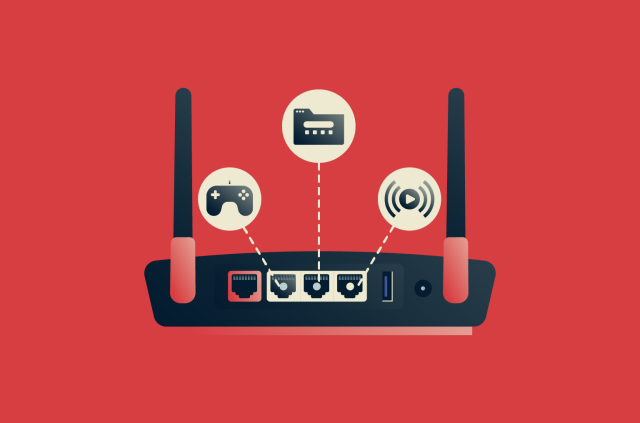What is IoT connectivity, and how do you choose the right solution?

Internet of Things (IoT) devices rely on connectivity to send data to the systems that process it and to receive updates when needed. The quality of that connection affects how reliably a device operates, how frequently it can report information, and whether it can function properly in the environment where it’s installed.
This article explains what IoT connectivity means and how it affects the way devices perform. It also examines what to consider when choosing a connection, the issues that arise as more devices are added, and the security and management practices that help keep an IoT setup reliable.
Understanding IoT connectivity
IoT connectivity refers to how devices reach the services that receive and interpret their data. These connections let the device send measurements, status updates, and alerts and allow the system to deliver configuration changes or new software back to the device. Without a reliable way to exchange this information, even well-designed devices can’t operate as intended.
Every IoT setup follows a similar sequence: the device sends its data to the service that processes it and receives updates through the same path when needed. The specific networking technology that carries the data can vary, but the idea is always the same: the device must maintain a dependable route to the system that manages it.
How IoT devices communicate
A device begins by joining the network available at its location, such as a home network, an office network, a shared mobile hotspot, or a built-in cellular link. Multiple IoT devices can coexist on the same network, and in some cases, they may communicate with each other directly.
Once a device has connected, it sends its readings to the system responsible for handling them. Depending on the design, that system may run in the cloud, on a local server, or on a nearby controller such as a phone. Remote clients, like mobile apps or web dashboards, often access devices through the cloud platform. Local clients on the same network can also interact with devices directly, without sending traffic over the internet.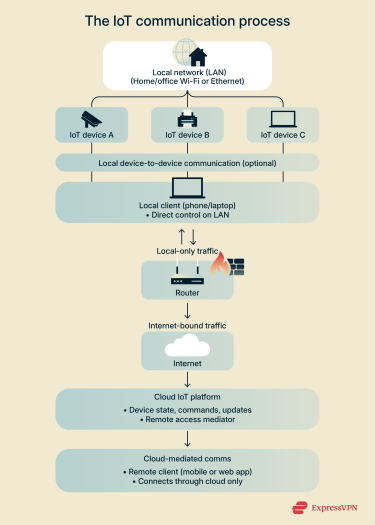
Some devices can’t reach the internet directly. They may use very short-range signals to conserve power or may be designed to communicate only with a nearby hub. In those setups, a gateway receives the device’s local signals and forwards the information through a conventional internet connection.
Types of IoT connectivity technologies
IoT devices rely on different communication methods depending on how far they need to reach, how much power they can use, and how much data they must send.
Cellular
Cellular networks cover wide areas and let devices connect from anywhere a carrier has a signal. A device connects through the nearest available cell tower and can send data whenever the network is reachable.
Standard 4G and 5G support higher data rates, which helps when a device needs to send larger data packets or frequent updates. This makes them practical for connected vehicles, roadside cameras, and industrial systems that send frequent or higher-volume updates, but performance still depends on tower placement, terrain, and how busy the network is.
Carriers also offer cellular options designed for devices that send small, occasional messages:
- Long Term Evolution for Machines (LTE-M): Supports mobility and includes power-saving features that let devices sleep for long periods and send short, periodic updates when needed. It’s common in utility meters, environmental sensors, and asset-tracking devices.
- Narrowband IoT (NB-IoT): Uses narrow radio channels to send small packets with minimal power use. It’s suited to fixed sensors such as water meters, leak detectors, and equipment placed in hard-to-reach indoor areas.
Wi-Fi and Ethernet
Wi-Fi and Ethernet are typically used in environments where a stable local network and reliable power supply are available, such as office buildings and industrial sites.
Wi-Fi connects a device to a nearby router over short distances and is often used for indoor devices that remain in one place and exchange moderate amounts of data. Ethernet uses a cable to link a device directly to a switch or router; because it avoids wireless interference and offers consistent performance, it’s favored for equipment requiring very high reliability, such as industrial controllers and access-control systems.
Bluetooth and Bluetooth Low Energy (BLE)
Bluetooth is a short-range wireless technology used for communication between nearby devices, typically within a few meters. It creates a direct link between the device and something close by, such as a phone or tablet, which handles any further processing or connectivity.
Bluetooth Low Energy (BLE) is the power-efficient version designed for small, occasional data transfers. It appears in fitness trackers, medical wearables, and proximity sensors because it uses very little energy and is built for devices that need long battery life while sending brief updates.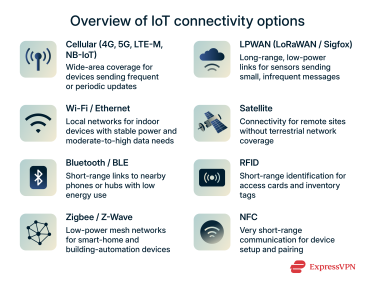
Zigbee and Z-Wave
Zigbee and Z-Wave are low-power wireless options often used in smart homes and building-automation systems. Both support mesh networking, where certain devices relay messages for others so signals can reach the hub even when sensors are spread across multiple locations. Devices such as lighting controls, sensors, and smart locks often use these technologies.
Zigbee uses the 2.4GHz band and offers multiple frequency channels to reduce interference when Wi-Fi networks are active in the same area.
Z-Wave uses sub-GHz frequencies, which are less crowded than the common 2.4GHz band, so devices face fewer interference issues.
LPWAN
Low-power wide area network (LPWAN) technologies support devices that send small amounts of data over long distances while using very little energy. They’re suited to sensors that check in periodically rather than staying consistently active.
- Long-range wide area network (LoRaWAN): Can cover several kilometers outdoors, depending on terrain and where gateways are placed. It appears in soil-moisture sensors, parking sensors, water-level monitors, and other devices that send only a few updates per hour or per day.
- Sigfox: A managed LPWAN service designed for tiny, infrequent messages. Examples include alarms and parking sensors that transmit only a few bytes at a time.
Satellite connectivity
Satellite networks provide communication in areas where land-based networks don’t reach. A device sends data to a satellite modem, which relays it to a satellite and then to a ground station. Satellite links usually have higher delay and lower data rates than terrestrial networks.
Satellite is commonly used in wildlife and environmental tracking, remote monitoring stations, and maritime asset applications, and performance depends on satellite visibility, weather conditions, and system design.
RFID
Radio-frequency identification (RFID) uses small tags that store an identifier and respond when a nearby reader sends a short radio signal. It’s common in access cards, inventory labels, and asset-tracking tags because it’s designed for quick identification at close range.
NFC and other short-range protocols
Near Field Communication (NFC) is a wireless technology that enables secure communication at very short distances. It’s used for tap-based actions like payments, unlocking doors, or pairing a phone with a device. In IoT, NFC often helps during setup. It can load configuration details into a lock, appliance, or sensor, or link a device to a user’s phone.
Ultra-Wideband (UWB) is another short-range wireless protocol that provides highly accurate distance and direction measurements. It’s used in digital keys, asset tracking, indoor positioning, and secure proximity detection. In IoT deployments, it can complement NFC by enabling precise ranging and location-aware features that go beyond simple tap-and-configure interactions.
Real-world use cases
Here are some ways that IoT connectivity is implemented across various industries.
Smart buildings
Homes and offices rely on sensors that track temperature, occupancy, lighting, and security. These devices stay indoors, run on stable power, and send frequent but small updates. Wi-Fi and similar indoor wireless options work here, because access points can be placed to cover the rooms or areas where sensors are installed.
Industrial environments
Industrial IoT (IIoT) deployments in factories often mix wired equipment for precision tasks with wireless sensors spread across the site. Equipment that handles precise timing or safety-critical tasks is often wired, since cables provide predictable performance and avoid the variability of wireless signals. Devices installed outdoors or far from cabling may use mobile networks to report status or support remote monitoring.
Agriculture and remote monitoring
Agricultural and remote-site deployments often rely on sensors placed across wide outdoor areas where power and connectivity are limited. Many of these devices run on batteries and are designed to send small, infrequent readings rather than continuous data streams. Long-range, low-power radio systems such as LoRaWAN or Sigfox are widely used in these environments because they let sensors communicate over distance while keeping device power use low. Where no ground network reaches, satellite connections fill the gap.
Fleet and logistics
Vehicles, containers, and delivery equipment need a connection that works while in motion. Mobile or satellite networks are typically used so devices can report location, condition, or security events throughout a trip. Broad coverage helps dispatch teams track assets, adjust routes, and respond to delays.
Healthcare and wearables
Personal medical devices prioritize low power use and must function as the wearer moves through different environments. They usually send data to a nearby phone over a short-range wireless link, and the phone may forward it to cloud services for storage or analysis.
How to choose the right IoT connectivity
Choosing the right method depends on where the device will operate, how much data it needs to send, how quickly it must respond, and how often it can use its radio. Here’s what to look for.
Coverage and signal range
Materials like concrete, brick, and metal absorb or reflect wireless signals, which can reduce real-world coverage compared with manufacturer estimates. Testing the device on-site is the most reliable way to confirm actual coverage.
Short-range options like Wi-Fi, Bluetooth, Zigbee, and Z-Wave are common indoors, but their performance can fall across floors or thick walls or in enclosed spaces.
For deployments over larger areas, LTE-M, NB-IoT, or LoRaWAN are used when there’s suitable cellular coverage or an accessible LoRa gateway. In locations with no terrestrial networks, satellite connectivity offers a fallback.
Data bandwidth requirements
Different applications require different quantities of data. Some devices send only a few bytes per reading, while others upload logs, images, or occasional firmware updates.
Wi-Fi, Ethernet, and 4G or 5G are preferred when the device must handle larger transfers or intermittent bursts of data, since these networks support higher throughput. NB-IoT, LTE-M, LoRaWAN, and Sigfox suit devices that send small, periodic sensor values because they’re designed for low-bandwidth messages. A low-bandwidth network is viable only when you’re confident the device won’t need substantial uploads like diagnostics or firmware packages in the future.
Latency
Latency matters when timing affects the task: for actions that must happen quickly (unlocking a door, controlling equipment, acknowledging alarms), use Wi-Fi, Ethernet, or 4G/5G, since they typically provide lower latency and stable round-trip times. For tasks that tolerate slow responses (environmental readings, meter reporting), NB-IoT, LoRaWAN, and Sigfox are sufficient.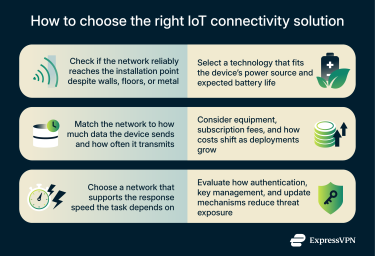
Power consumption
Battery life limits many IoT deployments. Networks that keep radios active (such as Wi-Fi or 4G/5G) use more power and are practical only when the device has a stable power supply. For devices installed in hard-to-reach places or expected to run for long periods without servicing, NB-IoT, LTE-M, LoRaWAN, and Sigfox support long sleep intervals and short transmissions.
Cost and scalability
Costs include hardware, installation, subscription fees, gateway placement, and maintenance. Wi-Fi, BLE, Zigbee, and Ethernet rely on local IoT infrastructure and have no per-device network fees but require on-site equipment.
LTE-M, NB-IoT, and 4G/5G involve carrier fees but reduce the need for local gateways, and LoRaWAN may be inexpensive at scale if gateways are already available. Satellite has the highest recurring cost, but it’s necessary where no other network exists.
Scaling from dozens of devices to thousands often shifts the cost balance, especially when gateways or battery replacements are involved.
Security
IoT security depends on authentication, key storage, update mechanisms, and how data is protected once it reaches cloud platforms.
Networks differ in their security models, but the biggest risks usually come from poor key management, insecure onboarding, or outdated firmware. Short-range systems limit exposure by requiring physical proximity, while wide-area networks rely more heavily on strong provisioning and encrypted transport. Review the entire path (from device to gateway to cloud) to identify where data or credentials could be exposed.
Hybrid connectivity models
A hybrid IoT connectivity approach, like combining LoRaWAN with satellite, for example, can give businesses the best of both worlds. When devices move across environments or enter coverage “dead zones,” they can switch between networks, enhancing reliability and reducing blind spots.
Common connectivity challenges
Even with a well-chosen architecture, teams often run into these hurdles.
Weak or unstable signal
Signals can drop when materials or distance reduce the strength of the link. A device that works on a desk may stop responding once mounted behind metal, inside cabinets, or in below-ground rooms. Even long-range systems can fail when the signal path is heavily obstructed or partially enclosed.
Interference from nearby equipment
Wireless performance often degrades when multiple systems use the same or neighboring frequencies. Crowded Wi-Fi channels, overlapping Bluetooth activity, and electrical noise from machinery can cause slow responses or brief disconnects.
Insufficient bandwidth
Some networks can’t support large or frequent updates because shared radio channels limit how much data devices can send at once. This happens when too many devices share the same access point or when low-bandwidth technologies are used for logs, images, or similar data.
High latency
Devices like smart locks, alarms, and real-time control systems require low latency because delays can affect their behavior. Higher latency can appear on satellite links, congested networks, or low-power systems that sleep for long periods before sending their next message.
Gateway or access-point placement
Technologies that use hubs or gateways depend heavily on their placement in most deployments. A gateway that is too far away, behind metal, or tucked into corners can cause dropouts because the device falls outside the gateway’s effective coverage area.
Configuration and scaling issues
Misconfigurations like incorrect credentials or outdated firmware can lead to intermittent failures. As deployments grow, capacity limits emerge because wireless networks share the same radio channel. When many devices attempt to transmit at once, collisions increase, and the gateway or access point may not receive every message reliably.
IoT connectivity trends to watch
IoT connectivity is changing as networks improve and more processing moves closer to the device.
Rise of 5G in IoT applications
5G lets operators configure network slices: separate, reserved portions of the network with their own performance targets. A slice can offer more consistent latency or capacity when the operator provisions dedicated resources for it. This means an IoT system can run on a slice that avoids congestion from regular phone traffic.
Edge computing and real-time processing
Edge computing moves some processing from the cloud to devices or local gateways. Instead of sending all raw data upstream (to the cloud or central server), the device filters, compresses, or aggregates it locally and uploads only what’s needed.
Examples include detecting motion before sending an alert or summarizing machine-sensor readings instead of uploading every sample. This reduces bandwidth use and makes the system less dependent on continuous, high-quality connectivity.
In some cases, more capable IoT devices also run lightweight AI or machine-learning (ML) models at the edge. This doesn’t apply to very small sensors, but devices like cameras or wearables can use on-device inference to detect patterns or events faster and reduce the amount of data they send upstream.
eSIM and remote SIM provisioning
An eSIM is a built-in, programmable SIM. Instead of swapping a physical card, operators or device managers can activate it or load new carrier profiles remotely.
For IoT fleets, this cuts down site visits. Devices on poles, inside sealed units, or in remote areas can be activated or moved to another carrier from a central platform. Support varies by operator and hardware, but adoption is rising because it reduces installation and maintenance work.
The role of VPNs in IoT connectivity
VPNs play a vital role when it comes to securing IoT data transmission, and they’re used in a variety of contexts.
Why VPN matters for IoT security
A VPN encrypts the connection between an IoT device or gateway and its remote service. This prevents anyone along the network path from reading or altering the data the device sends or receives.
VPNs also reduce what intermediate networks can see. Instead of revealing which cloud services the device is contacting, the traffic is wrapped inside a single encrypted tunnel. The device still uses the internet, but outside observers can see only that it’s connected to the VPN server, not the specific services or data being exchanged.
Common use cases
- Smart homes: Consumer IoT devices and smart-home systems can route traffic through a VPN to create a secure connection to remote automation services. A VPN encrypts this traffic so that anyone on the network path, including an internet service provider (ISP) or someone on the same Wi-Fi network, can’t read or alter it. This helps protect routine activity, such as status updates, configuration data, and control requests.
- Business IoT: Retail terminals, access-control panels, and environmental sensors sometimes need to send data to company servers. Without encryption, someone on the network path could view sensitive data in transit (for example, transaction details or building-entry logs). A VPN prevents this by encrypting the traffic before it leaves the site.
- Industrial IoT: Remote tools like field gateways and monitoring units often communicate with central control systems. If this traffic were sent without protection, someone with access to the network path could observe operational readings or alter the data. This is one way IoT attacks can disrupt how remote systems behave. A VPN ensures that only the intended control system can read the data sent from the field devices.
Limitations of VPN in IoT
VPNs can introduce technical and operational challenges that can affect device performance and long-term reliability. This is because they:
- Require continuous processing: Maintaining a VPN tunnel needs CPU and memory to encrypt and decrypt traffic. This is difficult for small IoT devices designed with very limited hardware.
- Consume more power: VPNs use more power because the device must periodically send small signals to show the VPN connection is still active, and it must continuously encrypt and decrypt its traffic. This extra work drains the battery faster, which is why VPNs are rarely used on tiny IoT sensors that need to run for years on a single battery.
- Add protocol overhead: A VPN wraps each message in additional security and routing information, which makes the message larger. On slow or low-bandwidth networks, this extra size reduces how much useful data the device can send and increases latency.
- Are sensitive to weak connections: Devices on networks with frequent drops, weak signals, or heavy congestion can struggle to keep a VPN tunnel active because the connection must stay stable in both directions.
- Are harder to scale and manage: Scaling a VPN across thousands of IoT devices adds operational overhead. Every device must have proper credentials, the VPN server must manage many connections at once, and devices that connect only sporadically make tunnel management more complex.
VPN vs. private APN vs. TLS: Which is best for IoT?
A VPN encrypts all traffic between an IoT device or gateway and a remote server. It’s useful when devices need a protected path to a private system that isn’t reachable over the public internet, or when a project wants all device traffic to pass through one secured point. VPNs work best on gateways, routers, or larger devices because they require more processing power and a stable connection.
A private access point name (APN) keeps cellular-connected devices inside a carrier-controlled network instead of sending their traffic across the public internet. This gives organizations a controlled environment without installing VPN clients on every device. Private APNs work well for large fleets that mainly send data to internal systems and benefit from carrier-level traffic isolation.
Transport Layer Security (TLS) encrypts data directly between a device and the cloud service or server it communicates with. Instead of encrypting all traffic like a VPN, TLS protects individual application-level sessions with much lower overhead. This makes it suitable for small or low-power IoT sensors that send periodic updates to cloud platforms and can’t support the overhead of maintaining a full VPN tunnel.
Managing and scaling your IoT connectivity
As IoT deployments grow, managing devices and long-term support becomes as important as choosing the right connectivity method.
Use a connectivity management platform (CMP)
A connectivity management platform (CMP) gives operators one place to monitor and control large numbers of connected devices. Most CMPs come from mobile operators or specialist IoT connectivity providers.
A CMP lets you:
- Activate or deactivate SIMs and eSIM profiles at scale.
- Track data usage and connection status to spot outages or unusual behavior.
- Set security rules, such as limiting which servers devices can reach.
- Automate alerts and diagnostics to reduce downtime.
CMPs are used in logistics, metering, fleet management, and any deployment where manual oversight doesn’t scale.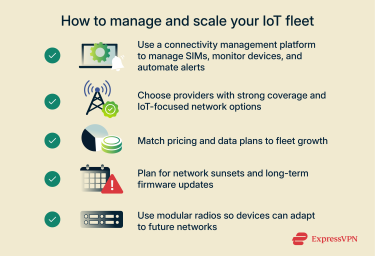
Partner with reliable connectivity providers
Large IoT projects depend on the quality and stability of the connectivity provider. Key factors include:
- Coverage and network reliability where devices will operate.
- Support for IoT-focused technologies.
- Clear commitments around uptime and how quickly the provider will address connectivity issues.
- Flexible pricing models that scale.
Choosing the right provider reduces operational risk and keeps devices online as fleets grow.
Plan for network lifecycle and evolution
IoT devices can remain in the field for many years. Planning for network changes early helps avoid expensive replacements later. Key considerations include:
- Network sunsets: Many countries have retired 2G and 3G; devices should support modern options like 4G, LTE-M, or NB-IoT.
- Updates: Devices must be able to receive firmware and security updates throughout their lifetime.
- Modular radios: Industrial devices often stay in service for many years. Using a replaceable connectivity module lets organizations upgrade the radio when networks change without replacing the entire device.
- Future network features: Newer technologies like 5G Standalone (5G network that operates independently of any 4G infrastructure) and updated LPWAN standards may offer improvements in coverage, power efficiency, or latency.
FAQ: Common questions about IoT connectivity
What’s the difference between LPWAN and cellular IoT?
Low-power wide area network (LPWAN) supports very small, infrequent messages and is designed for long battery life, which suits sensors that report occasionally. Cellular Internet of Things (IoT) works with higher data rates and supports mobility, so it’s used for devices that need broader coverage, more frequent updates, or near real-time communication.
Is Wi-Fi suitable for industrial IoT applications?
Wi-Fi can work in industrial settings when devices operate in enclosed areas with manageable interference, such as offices, control rooms, or indoor equipment bays. It’s less reliable on factory floors or large open sites where machinery, metal structures, and distance can weaken or disrupt the signal.
How does 5G change IoT connectivity strategies?
5G introduces network slicing, which lets operators create separate virtual networks with dedicated performance characteristics. For Internet of Things (IoT) devices, this means a deployment can run on a slice optimized for low latency, high reliability, or guaranteed bandwidth, rather than competing with regular mobile traffic.
What’s the best IoT connectivity option for rural deployments?
Rural deployments depend on what networks are available: cellular where coverage exists, low-power wide area network (LPWAN) for long-range low-data sensors, and satellite where no ground networks reach. The choice depends on the site and the device’s data needs.
Take the first step to protect yourself online. Try ExpressVPN risk-free.
Get ExpressVPN











